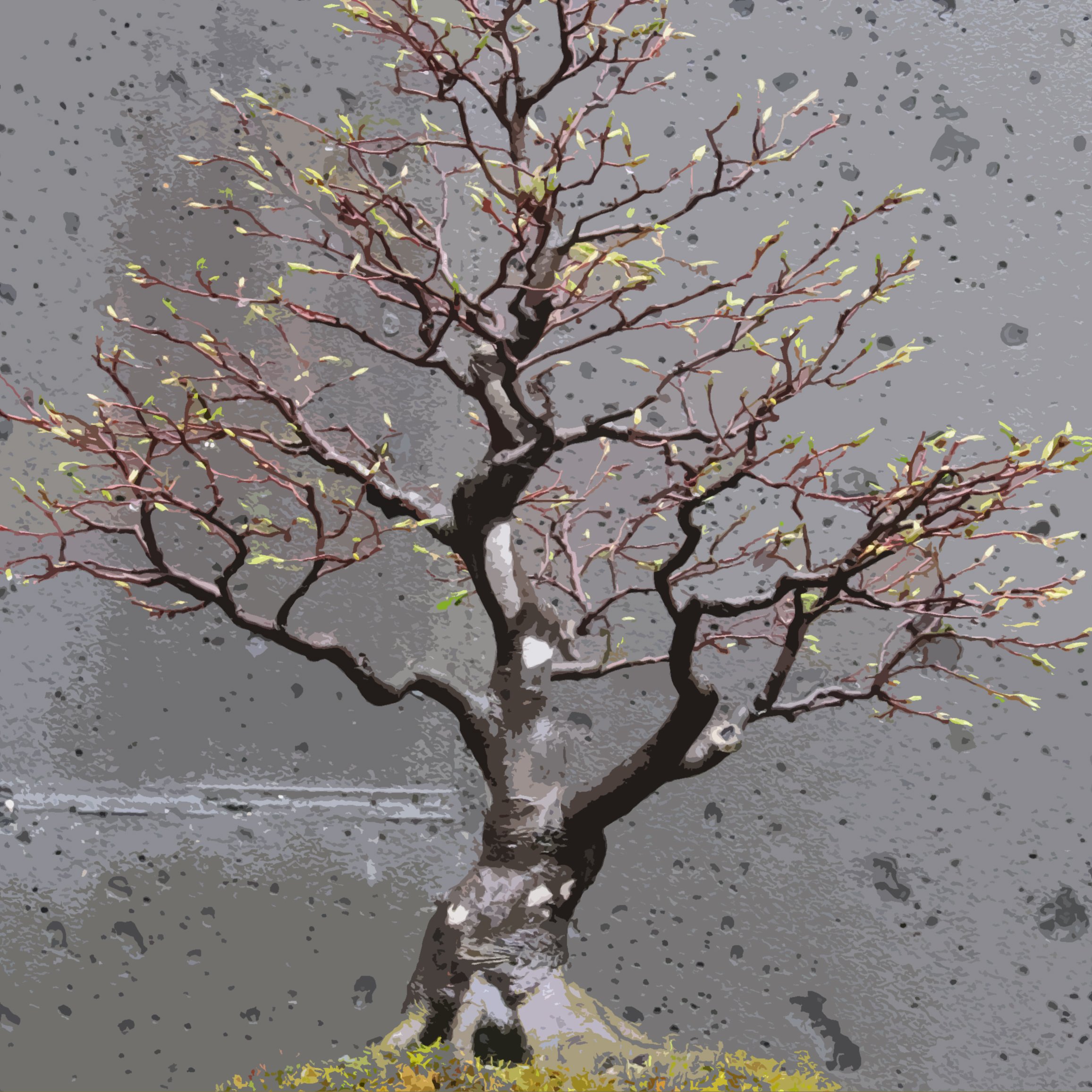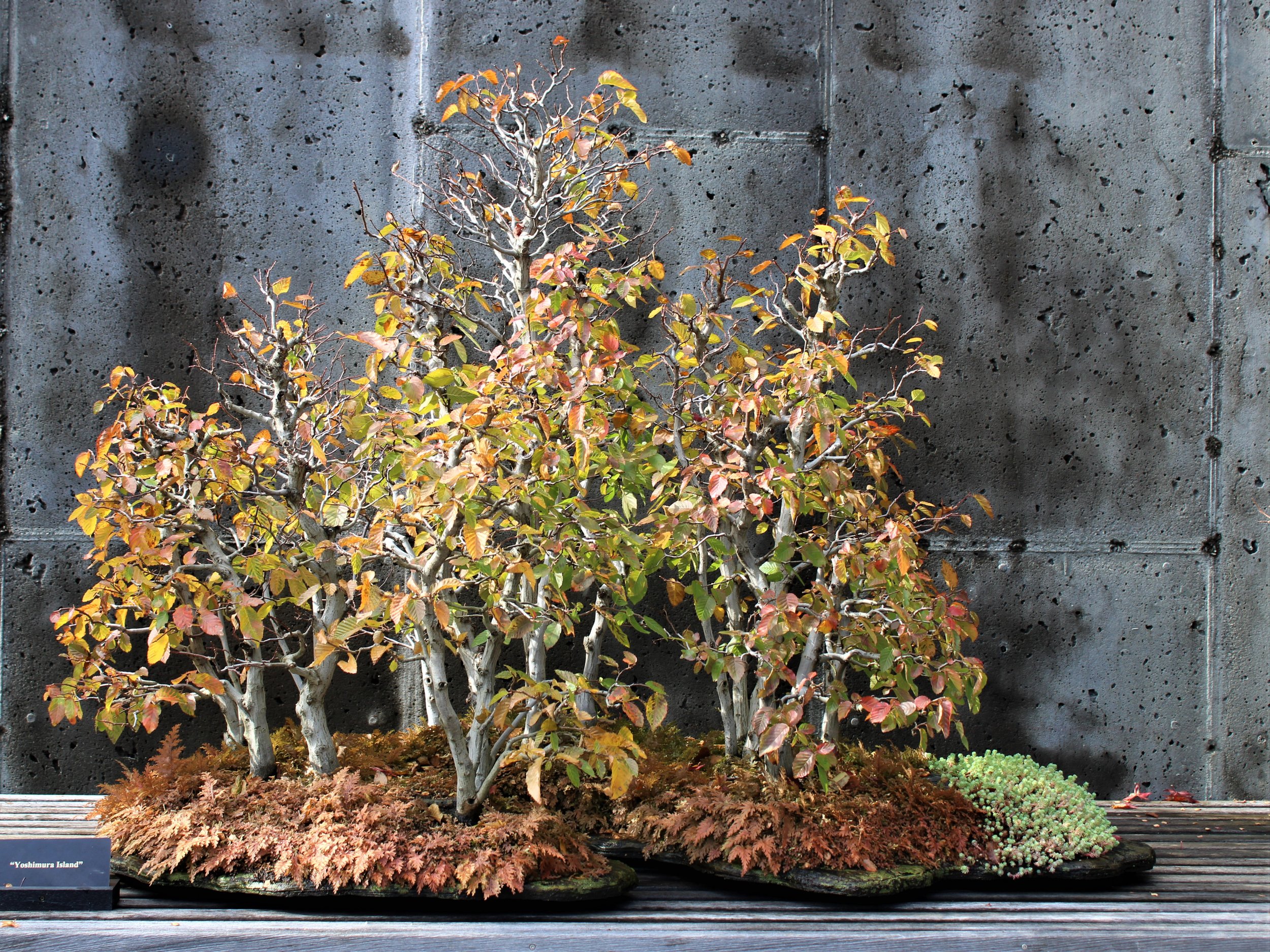American Hornbeam
American hornbeam (Carpinus caroliniana) lacks the gaudy gene. It is an admirable tree species with four seasons of visual interest, but its appeal is understated and its virtues are so soft spoken that they are easily overlooked. I can't say I took much notice of American hornbeam either, until bonsai gave me reason to focus on it.
If one were to draw up a list of the overall best American native tree species for bonsai use, American hornbeam would deserve to be on it and be somewhere close to the top. This deciduous tree, alternately known as Blue-beech, Water-beech, Ironwood and Musclewood, has no difficulty adapting to container culture. It is not especially prone to insect or disease problems, will reliably produce new growth on old wood when pruned, and its leaves reduce well with bonsai training. American hornbeam can be used to create virtually any bonsai form, from formal upright to recumbent, and they are also excellent for group plantings and tray landscapes.
The North Carolina Arboretum bonsai collection features several outstanding American hornbeam specimens:
While not a true bonsai because it is planted in the ground, this American hornbeam in the bonsai garden’s upper plaza is pruned five or six times over the course of a growing season.
American hornbeams are endemic to a wide swath of eastern North America, from southern Canada to northern Florida, west to Minnesota and eastern Texas. In nature, American hornbeams are an understory species, capable of growing to thirty feet or more in height with a potentially comparable crown spread. They can have single or multiple trunks, and the smooth, light gray bark and sinewy, fluted look of the trunk makes it a primary feature of interest. In spring the pale green-yellow catkin flowers are subtly attractive, later becoming tiny nuts borne in clusters of papery, leaf-like bracts known as an involucre. This fruiting structure has visual interest in the landscape but rarely appears when hornbeam is grown as a bonsai. Autumn color can be pleasing, ranging from orange to yellow, but on some individual trees it is not much to speak of. More ephemeral than the autumn color but still a beautiful feature, especially as bonsai, in spring the tiny new leaves come out in red before turning green when they enlarge. American hornbeam prefers partial to full shade and moist, rich, organic soil, so they frequently occur alongside streams and rivers. But the species is adaptable, and will grow comfortably as a landscape specimen and even as a street tree.
A visually striking planting of American hornbeam along a walkway at Longwood Gardens in Pennsylvania.
American hornbeam enjoys prominent placement in the plaza out front of the Education Center at The North Carolina Arboretum.
Regrettably, American hornbeam is not so readily available in commercial trade, although a few cultivated varieties are starting to turn up in higher-end nurseries. This obstacle to availability is mitigated, though, by the tree's wide natural distribution and the fact that they are not so difficult to collect or grow from seed.
As it happened, some of the very first trees I worked with when learning to make my own bonsai were American hornbeams, and this is the story of one of them.
Folks who are familiar with the Arboretum know that the Production Greenhouse is about half a mile removed from the core garden area. Greenhouse Way is the thorofare connecting the two. What is not so well known is that the landscape all along that road was not only designed and planted by Arboretum staff in the early 1990s, but almost all the plant material was produced in an Arboretum field nursery. Among the few trees that did not come out of the nursery were six American hornbeams planted on either side of the road near its terminus, just before the sharp left turn that leads to the greenhouse parking lot. They can still be found there today. Those trees were collected as young saplings out of the woods in Sylva, North Carolina, by the person who was the Grounds and Gardens Supervisor at the time. He had collected about a dozen trees in total, and they were all about five-to-eight-feet in height. Those that were not planted in the ground were "gang-potted" in a large plastic tub and then left out back of the greenhouse where they could be watered when someone thought of it. Predictably, while all the hornbeams planted in the landscape prospered, the unchosen trees languishing in the communal pot and suffering the indignity of neglect did poorly.
Some of the American hornbeam collected from the woods in Sylva and planted along Greenhouse Way.
In the spring of 1994 I was starting my second growing season as a fledgling bonsai curator. Back in those days I was doing everything I could to educate myself in this new field of responsibility, and I was literally reading bonsai books at night and then coming in to work the next day and attempting to do the things I read about. Yuji Yoshimura's The Japanese Art of Miniature Trees and Landscapes was the book I referred to most often, but I also spent a lot of time with Harry Tomlinson's The Complete Book of Bonsai and Dorothy Young's Bonsai the Art and Technique, among others. One development method I read about involved taking a sapling tree that had attained some size and cutting it down to a stump, waiting for it to re-sprout and then building a bonsai from that. It sounded promising and I decided to try it. One day at work I noticed the tub of miserable, neglected hornbeams and it was pretty obvious no one cared about them, so I asked if I could make use of whatever live ones remained. Permission was given. I rooted through the lot and found two that still had reasonable life left in them. These I took and cut down to approximately six-inch stumps and potted up individually in large plastic containers. When the coworker who had originally collected them saw what I'd done he said, “If I knew you were going to do THAT to them, I wouldn't have let you have them!” He was serious, too.
Back when I was doing this I had yet to learn the great value of photo-documenting all stages of a bonsai's progression, so I have no images to go with this part of the story. The first relevant picture I have is this one, made in the summer of 1995:
What is seen in this photograph is the abundance of stems and foliage produced by the stump after a year and a half of unrestrained growth. In truth, I do not know if this image is actually the stump that ultimately became the bonsai in question or if it is the other of the two I'd salvaged (that one eventually died), but it does not really matter. At this point both trees looked roughly the same. I do know that I made this picture just before doing the first pruning of the material, wherein the basic structure was initially laid out. Too bad there is no picture of that! In fact, the next image of this specimen I can offer is from eight years later, in 2003:
Looking at the above photograph and comparing it to the tree as it looks today, it's evident that this particular specimen has followed a true course since its early design development. That is to say, the tree was laid out a certain way to begin with and has not changed so much over time, beyond the ramification and refinement it is hoped the passing years would bring to it. In my experience, this consistency is not so often the case.
Here is how this American hornbeam looked in 2005:
And here it is on display in the bonsai garden in 2008:
Astute observers may notice the preceding three images show this particular bonsai in three different containers. The size of each container is approximately the same; the changes were made as I experimented in an attempt to find the right combination of tree and pot. Interestingly, all three containers are the work of Sara Rayner from Red Wing, Minnesota, who is generally thought to be among the very best of American bonsai potters.
This particular specimen has been on display in the bonsai garden every year since the garden opened in 2005. It might be seen as prescient, therefore, that for the opening of the garden I made a logo image featuring this American hornbeam:
At its core the arrangement of the trunk and branches on this specimen represents the rudimentary understanding I had of bonsai design when I first styled the tree so long ago. Because I was following basic step-by-step instruction from books, the branching follows an all too familiar pattern: Branch on one side - branch on the other side a little higher up - back branch. The pattern continues that way the length of the trunk, starting about 1/3 up the height of the tree from the base, with the branches becoming more closely placed together as they near the apex. The trunk itself angles first one way and then the other, zig-zagging in a predictable pattern of decreasing increments and gradually tapering as it goes upward. It is textbook stuff.
The look of this bonsai diverges from the standard example in that the primary branches do not stick out horizontally or descend as is typically prescribed in bonsai teaching. That was not for lack of trying, however. In the early years I did wire the branches of this tree in an attempt to override their upwardly growing tendency, but they were stubborn about it and after scarring a few of them I backed off. Wire scars on the smooth bark of a hornbeam are more or less permanent, and of course undesirable. As a result, this specimen has been largely shaped through the clip-and-grow method, wherein bonsai are shaped almost entirely through pruning, and not by use of training wire. In the many years since I started working with this American hornbeam my concept of bonsai tree design has changed, largely because I put down the books I used to study, and started studying the natural example instead. The mostly ascending branches now look right to me.
Aside from avoiding the hazard of wire scars, a few things I've learned about American hornbeam in the years I've been growing this tree include:
Wounds are very slow to cover
The species appreciates moisture and does not like to dry out
Growing in full sunlight is possible if water needs are met, but some relief from the sun in the heat of the day is generally advisable
Splash from water-soluble fertilizer can burn leaves
With good pruning the tree can be prompted to initiate new growth repeatedly in a single growing season
Most people find American beech (Fagus grandifolia) to be a beautifully appealing tree in the landscape, but people who have tried them for bonsai know American beech is difficult to use for that purpose. American hornbeam is very similar to beech in both leaf and bark but cooperates so much better as a bonsai subject. For bonsai purposes, American hornbeam can play the part of American beech and do it better.






















